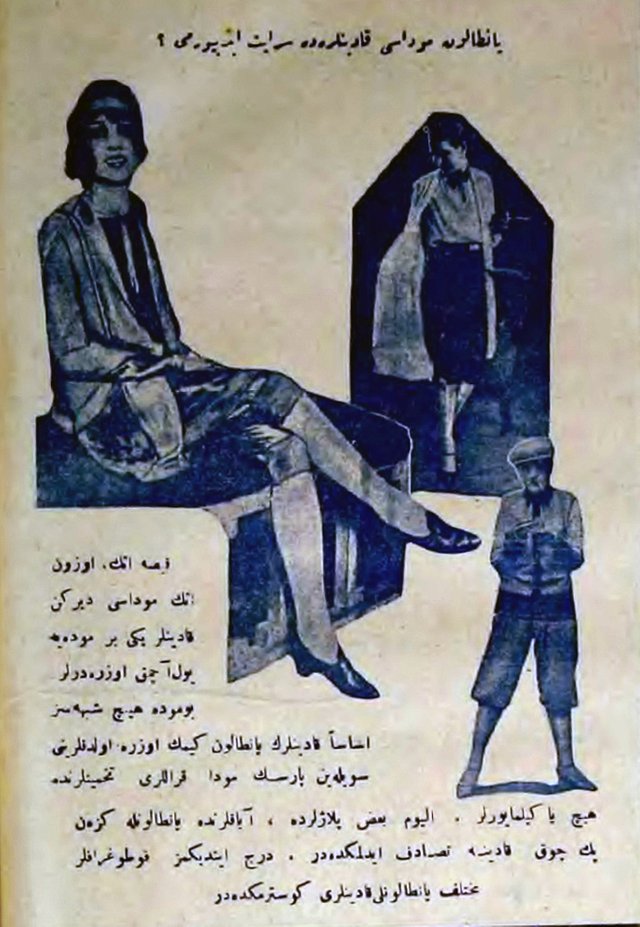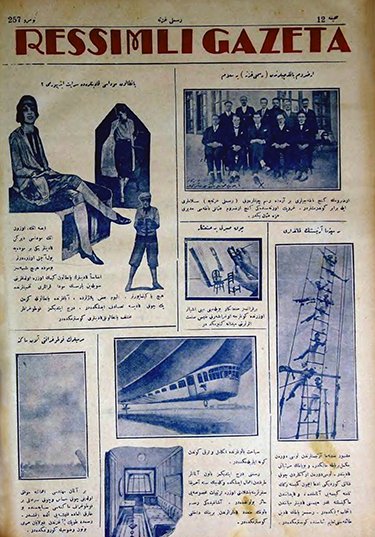101. Today in 1920s Turkey: 4 August 1928 (“Pants Trend” May Be Spreading To Women)

(“Pantalon Modası,” Resimli Gazete or “Illustrated Gazette,” 4 August 1928, no. 257, page 12.)
Türkçe:
Pantalon Modası Kadınlara da Sirayet Ediyor mu?
Kısa etek, uzun etek modası derken kadınlar yeni bir modaya yol açmak üzeredirler. Bu moda hiç şüphesiz esasen kadınların pantalon giymek üzere olduklarını söyleyen Paris’in moda kıralları tahminlerinde hiç yanılmıyorlar (Bu cümlede yüklem eksik, baskı hatasıdır herhalde). Elyevm bazı plajlarda, ayaklarda pantalonla gezen pek çok kadına tesadüf edilmektedir. Derc ettiğimiz fotoğraflar muhtelif pantalonlu kadınları göstermektedir.
English:
Is the Pants Trend Spreading to Women too?
After short skirts and long skirts now women are on the brink of turning a new page in fashion. The kings of fashion in Paris who are never wrong in their predictions say that undoubtedly this trend [missing verb?] women are actually about to start wearing pants. Today one can happen upon many women walking around wearing pants on beaches. The photographs we have included show various women with pants.
Comments
This short “fashion update” is fascinating for several reasons. Yes, it is interesting because it reminds us that women did not always where pants. But more importantly I find the tone of the article to be extraordinarily objective and ambivalent toward the impending “trend.” There is neither outcry for broken social taboo nor are there any women being mocked for “manliness” or “overstepping their bounds.” Rather, the trouser is treated here as just another garment that is free to be adopted by anyone. Since the 19th century fashion and clothing norms had changed rapidly in the late Ottoman Empire and early Turkish Republic (especially, in big cities like Istanbul). Thus, after decades of frequent clothing changes and styles, the onset of yet another “trend,” especially in women’s clothing, is not seen as particularly threatening. Besides, if women's pants are being sold in Paris, it will not be long before they will show up in the boutiques of Istanbul's posh shopping districts.
This brief blurb is one of several pop cultural stories featured on the back cover of the 4 August 1928 issue of the weekly journal, Resimli Gazete or “Illustrated Gazette.” This particular issue was published several months prior to the Alphabet Reform (Harf Devrimi)that will take place incrementally over the rest of 1928. In preparation for the transition from Arabic letters to Latin letters, all newspaper were required to start featuring the new numbers (most visible in pagination) in July. Other more forward-thinking papers such as Resimli Gazete started publishing their titles in the new letters well ahead of the November reform in a show of support. As such, this issue of Resimli Gazete maintains its original Arabic masthead on its front cover but has changed the title to Latin letters for the back cover.

(Entire page, Resimli Gazete or “Illustrated Gazette,” 4 August 1928, no. 257, page 12 also back cover.)
Speakers of modern Turkish today would recognize the spelling of Resimli Gazete as being different in 1928, where it has appeared instead as Ressımlı Gazeta. Far from mistakes or typos, these variations in spelling are actually quite common during the first decade of the alphabet reform as the new spellings are still settling in and becoming more standardized.
"Pants trend" of women?? What will we see next? Moving pictures...
Bah! Moving pictures are just a fad!
Very informative your post, I love: D
Thank you! Glad you enjoyed it:)
This is the influence of the changing age
Unstoppable, it seems!
This post has been modified, updated, and re-posted on 4 August 2018. Access the new edition here.